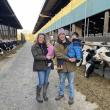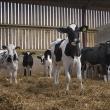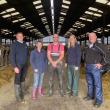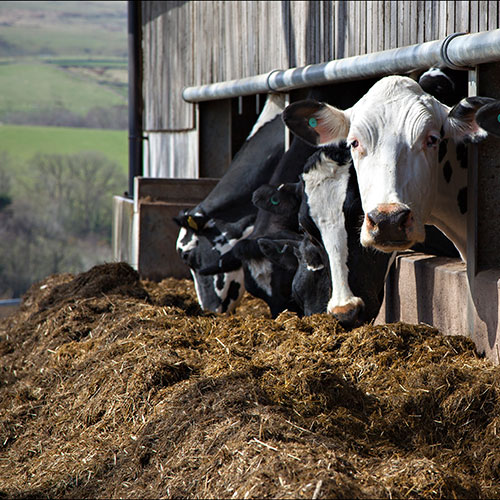After Advanced Nutrition's advice and using DC X-Zel for our transition cows we have found they are fitter and healthier. They don’t lose much condition after they calve, right through to lactation. They just calve down better.
Achieving Better Foot Health in Dairy Herds
Eoghan Mullery, Technical Director from Advanced Nutrition, talks to Dr. Nick J Bell, Veterinary Surgeon and Director of Herd Health, to discuss practical steps herd managers can take to improve foot health in their dairy herds. First published in British Dairying.
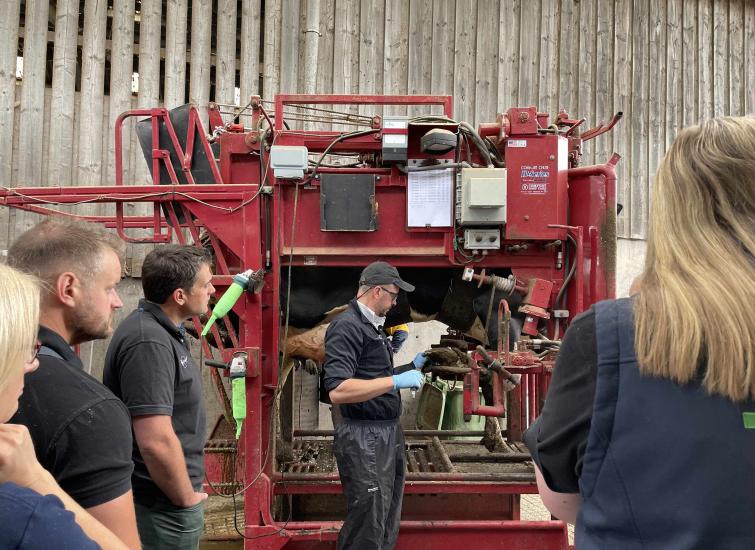
The Importance of Foot Health
Lameness is a major issue in dairy farming, impacting productivity and cow welfare. As we explored in our April issue, the connection between nutrition and lameness is critical but it also extends to other parts of the business. That's why the team at Advanced Ruminant Nutrition have a holistic approach which, includes drawing on experts like Dr Nick Bell, to help farmers create long-term strategies for preventing lameness. It’s a whole farm, whole team approach.
“Everyone knows lameness is a huge problem on farms. It stops us from getting the best out of our cows,” says Eoghan Mullery. “When we get asked to visit a dairy with a lameness or mobility problem, the farmers often feel overwhelmed by the challenge. This is common, but we should take confidence from herds that manage to achieve great results in tackling the problem. It’s why Advanced Ruminant Nutrition and Herd Health Consultancy have worked together over the last few years.”
Nick adds, “In the daily grind of foot trimming, bathing, and other regular practices, it can be tough to see a clear path forward. Every farm is different, but the key is to make a plan that addresses the main obstacles.”
Eoghan emphasises, “The biggest bottleneck to reducing lameness is knowing where to start. Expert advice can generate a huge to-do list, often seeming unachievable, but we must begin somewhere. Creating a plan that prioritises the 'easy wins' and gradually tackles the bigger challenges is crucial. For most farms, this is a 2-3 year process. Identifying the causes of lameness is the only way to prevent it. While we can treat the current problem, unless we address the root cause, we'll remain stuck in a cycle of treatment, as Nick highlighted earlier.”
Nick agrees, “It’s also about understanding the farm’s limitations. What can you tackle right now? For example, improving the grooving on shed floors to prevent slipping might not be feasible if there’s no budget for it. In that case, what else can we do?”
Where to Start: Practical Steps
Nick suggests five key steps to improve foot health in your herd:
Step 1: Quantify Foot Health
“First, you need to know where you stand,” says Eoghan. Nick recommends starting with a mobility score from an experienced and professional RoMS scorer. “Having a professional scorer helps you spot cows before they become lame and provides valuable insights from a scoring session. Don’t hesitate to discuss and refine these scores together to fully grasp the problem’s scope.”
Nick advises, “Conduct your score the day before a trimmer visit. This way, all score 2 and score 3 cows can have their feet lifted. You can then look at the types of lesions you have and prioritise from there. If you find sole ulcers, white line infections, and large digital dermatitis lesions, you were too late. Ideally, fewer than 1% of cows should be affected by sole ulcers and digital dermatitis.”
Eoghan adds, “Getting the whole team on board is crucial. Look at what you can do and when, prioritise actions that will yield the most gains, understand your limitations, and manage expectations. Set realistic KPIs for years 1, 2, and 3. This isn’t a quick fix, but a long-term plan will improve lameness and the herd’s sustainability.”
Step 2: Focus on Foot Trimming
“After your mobility scoring, plan your trimming slots throughout the year,” advises Nick. “Most high yielding Holstein herds need 4-5 visits to the crush per cow on average. Ensure you have enough trimming slots to cover all the mobility score 2 and 3 cows you found during scoring, plus any high maintenance cows and rechecks. This should be in addition to budgeting for two to three routine trims, per cow, annually.”
Nick stresses the importance of correct foot trimming technique. “Foot trimming recommendations have advanced significantly in the last twenty years. It’s essential to get the technique right before doing more trimming; otherwise, you could worsen the problem. This element can be transformative but old habits can be hard to shake for any of us. Use professional, up-to-date trimmers. And always have someone on the farm skilled at treating cows any day of the year. The aim is to treat them before they are noticeably lame.”
“Treat mobility score 2 cows as an emergency,” Nick continues. “Aim to treat these within 24 hours. You wouldn’t leave a cow with mastitis untreated for a month, and the same urgency applies to cows with foot lesions. Ensure the trimmer knows which cows and which legs to check for mobility score 2 and 3. Early treatment of deep bruises with a block and anti-inflammatory is the key to good cure rates. Someone trained to carefully spot cows every 1-2 weeks as they walk past you can be highly efficient for this, but some herdspersons do this instinctively every time they look at a cow.”
Step 3: Implement Farm Team Protocols
Getting the full team on board is crucial. The Advanced Mobility program offers a comprehensive approach, helping farmers develop bespoke protocols for their farms. This includes a systematic risk assessment during a farm walk, covering all areas cows walk, including youngstock, dry cows, and tracks.
Nick advises working with a vet to develop treatment protocols. “Check your prevention fundamentals. For sole ulcers, ensure good cubicle comfort, short pen times, and effective cow cooling and regular foot checks in the crush. For white lines, focus on cow flow, walkways, and claw horn quality. For digital dermatitis, prioritise daily foot cleaning and disinfection of lactating cows, and don’t forget foot bathing for dry cows and youngstock.”
Step 4: Diagnosis and Treatment
Eoghan and Nick provide insights into the most common lameness issues and key considerations for effective management:
Digital Dermatitis (DD)
- Best practice is monthly hosing of feet for blitz treatment
- Daily foot cleaning and disinfection with an appropriate biocide at the correct concentration and depth
- Regular foot baths for dry cows and youngstock
- Improved slurry management, especially around foot baths
- Disinfection during trimming with 2% hypochlorite, 1% FAM30, or 2% Virkon
- Ensuring strong biosecurity measures
Sole Ulcers
- Minimising standing times by optimising bedding, cubicle dimensions, pen times, heat abatement, stocking rates, and preconditioning heifers to concrete and cubicles
- Ensuring safe foot shape and appropriate trim intervals
- Big models especially when housed
- Screening for early bruising
- Effective treatment of bruising (EDPET method)
- Maintaining a high-maintenance cow list
- Implementing culling when necessary
White Line Disease
- Enhancing cow flow with quiet herding and handling, careful backing gate management, adequate space, sensible stocking rates, appropriate alley dimensions, housing design, and managed group movements
- Improving cow walkways with level but grippy concrete, optimal groove and texture, or targeted rubber or pasture surfaces
- Enhancing horn quality through biotin supplementation (20mg/h/d) and organic trace minerals tailored to yield

Necrotic Hoof Lesions
- Protecting sole depth
- Eliminating trim faults from the farm, such as not removing axial walls
- Establishing treatment protocols with the vet and trimmer
- Controlling DD
Thin Soles
- Employing sole-sparing trimming techniques
- Addressing wear issues
- Improving horn quality
Corkscrew Claw
- Reviewing rearing practices and feed barrier management
- Adjusting trim techniques accordingly

Eoghan and Dr Nick Bell both agree that working with your vet, nutrition consultant and a fully qualified and up-to-date professional trimmer can be a good way to find the first step. Make sure your trimmer understands why toe length recommendations have now changed, why the big model is so important to housed cows and the legislation on things like salicylic acid usage. A good trimmer will be in demand and so finding someone at Level 4 qualification and up-to-date on checks and audits is a priority.
By following these steps, you can take meaningful action to improve foot health in your dairy herd. It’s about creating a clear plan, involving your entire team, and making practical, impactful changes.
〈 BACK

